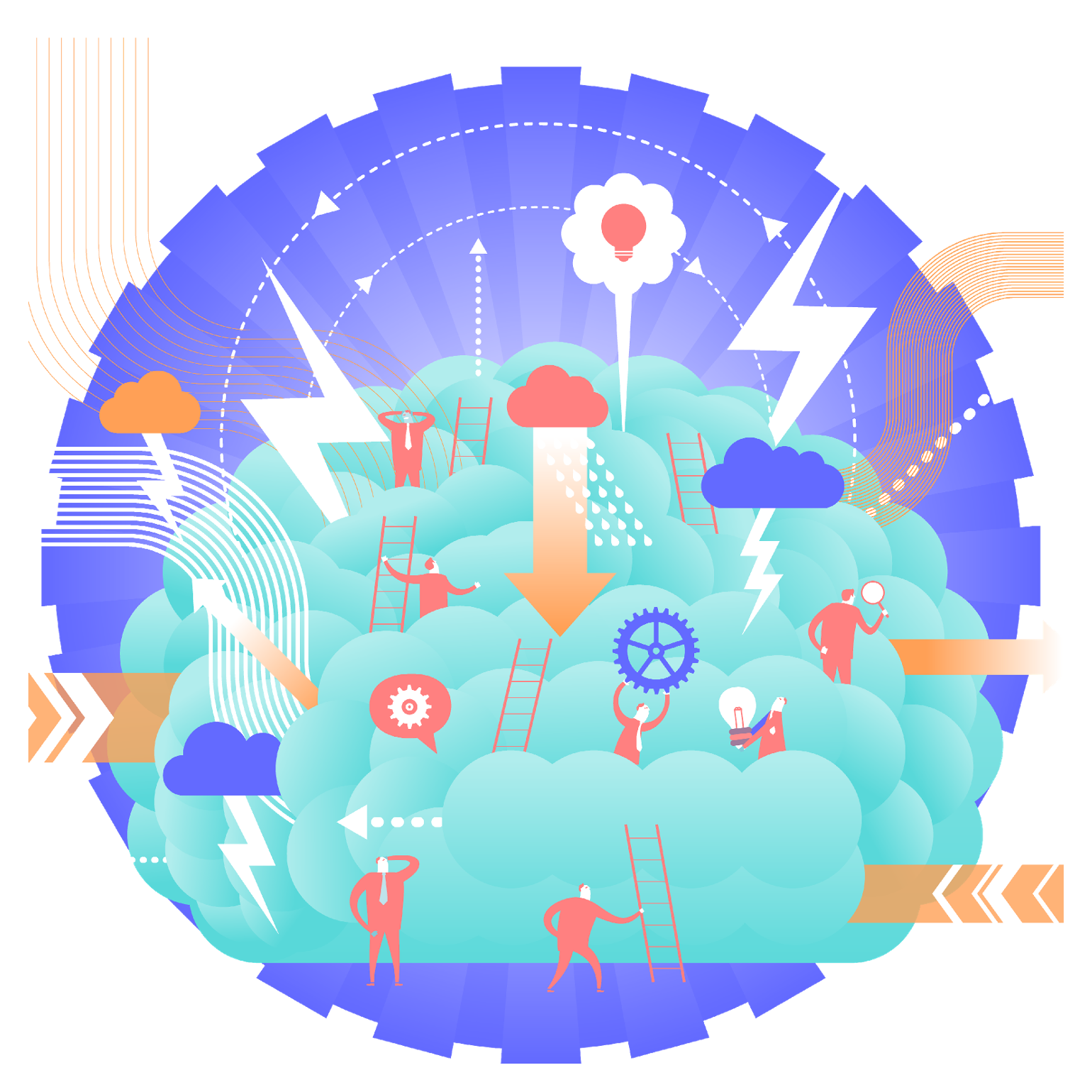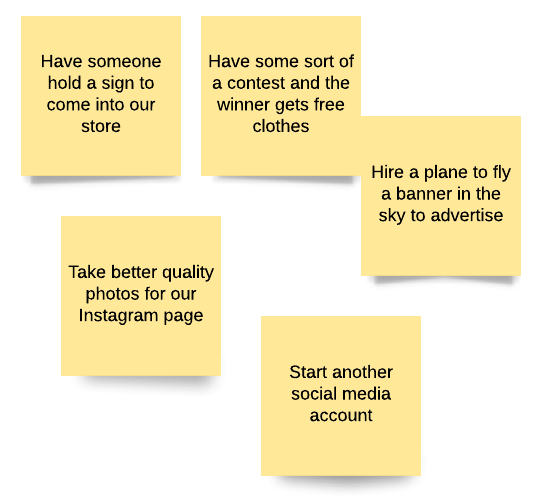
How to operate like a think tank within your company
Lucid Content
Reading time: about 6 min
Topics:
Whenever a breakthrough discovery is published, a new theory is endorsed, or a public policy is enacted, the research behind such work (and its findings) are often attributed to a “think tank.” We’ve all heard or seen the phrase, but what is a think tank, exactly?
A think tank is a group or team designated to create innovative solutions to problems.
Formal think tanks like the Brookings Institution focus on global societal issues. They work on projects dealing with economics, governance, and politics. However, you can incorporate parts of think tank culture into any business to drive creative problem solving and process improvement across your organization.
It’s as simple (yet arduous) as boldly making the decision to operate like a think tank.
What does it mean to operate like a think tank?
Operating like a think tank can quickly empower every team member to function at their full potential to solve a problem, overcome a challenge, or develop a plan together. With the right mindset and sense of purpose, almost any group can operate like a think tank.
Forming a think tank requires a group-wide commitment to a shared vision. Everyone must hold each other accountable for sustaining the culture and producing the desired outcomes.
Because of this, think tank members should view themselves as change-agents, willing and motivated to confront uncomfortable truths and persistent issues for the betterment of the company. Anyone who is up to the task should be given the freedom to operate.
Start small by hosting think tank sessions
In order to operate like a think tank within your organization, you need a starting point.
Consider kicking things off with an announcement at your next all-hands meeting or in a company-wide email. Outline your think tank’s objectives and why you’re taking this route to creative ideation. Next, host a meeting to bring interested parties together and introduce them to the concept.
After your introductory meeting, host a series of small and informal think tank sessions. This will allow you to become more familiar with the format while also giving you the chance to attract more potential members. These interactions will help you gain confidence as a facilitator and further highlight the qualities to look for in think tank participants.
Pick the right participants
Putting extra thought and time into selecting the members of your think tank will go a long way to ensuring its success. You’ll want a team made up of people from different departments or disciplines ready to approach any challenge from several viewpoints.
Although diversity is essential for a think tank, there are some universal traits to be mindful of when choosing participants for your team. Some of these traits include:
- A highly inquisitive or curious nature
- Out-of-the-box thinking and creativity
- Boldness and a willingness to take risks
- Flexibility and agile thinking
As a group, the think tank shares equal accountability for the results of each session. They will also share a responsibility to challenge opinions and question ideas formed by the think tank, building upon solutions, contributing to the discussion, and looking out for pitfalls along the way. The think tank’s success will be contingent on its group dynamic.
Establish session goals
A great think tank session doesn’t just inspire its participants, it also produces results.
This is only possible if you start by identifying a clear outcome for your meeting. Before each session, ensure that participants understand what to expect and how to contribute. By establishing goals you give your team a greater sense of purpose.
Of course, every meeting is different. Many times, your team will be focused on solving problems. Other times, participants will be tasked with making decisions on their next course of action. And sometimes, the think tank will be needed for their ideation and creative input. This is for you to identify.
Without purpose, it’s easy for a think tank to get distracted or to follow tangents instead of addressing the challenge (or opportunity) at hand. Use session goals as a guide to help keep your team on task.
Set some ground rules
When leading a think tank, explaining the mission and guiding the discussion aren’t your only responsibilities. It’s also important for you to set ground rules for the team. Nothing too formal, of course. But for a think tank to function effectively, guidelines are essential.
Before your think tank embarks on its first challenge, confirm that everyone is willing to:
- Treat one another with mutual respect.
- Ideate freely as they also stay on topic.
- Support cooperation and collaboration.
- Withhold judgement and hear every voice.
If one ground rule stands above the rest, it’s this: keep egos in check. The think tank is not a forum for participants to impress everyone with their knowledge or monopolize the conversation. By following a game plan, the think tank will generate ideas more quickly.

Feeling stuck? Get your team thinking big with these brainstorming techniques.
Read moreManage meeting time wisely
The quality and effectiveness of any think tank discussion varies greatly depending on how well it’s facilitated. To make the most of the time allotted to your meetings, always endeavor to:
- Set a start time and end time and ensure that they are followed.
- Provide structure and purpose to keep participants engaged.
- Have someone take notes to share the information with all participants afterward.
- Actively monitor whether time is being used efficiently or not.
As think tank facilitator, you must set the appropriate tone for the meeting. Participants should go into each think tank discussion with the understanding they’re embarking on something new and possibly revolutionary which can lead to real organizational change.
If the group isn’t fully invested or focused on the mission, stop the meeting. To operate like a think tank, everyone should show respect for each other’s time by using it wisely.
Evaluate the effectiveness of each session
Once the think tank discussion is over, the other work begins. This is time to reflect on everyone’s overall performance and level of participation, including your own.
As you evaluate the effectiveness of each session, ask yourself these questions:
- Which things made your session successful?
- How could the discussion be improved next time?
- What goals were met since the last meeting?
- Which tasks are still awaiting completion?
Remember to involve other participants and team members in your evaluation process. This can be accomplished by simply distributing the meeting notes to the entire group or keeping the information in a location that everyone can access. Although there’s always room for improvement, never undermine the actions or decisions made by your team.
The benefits of operating like a think tank
Operating like a think tank requires a heightened level of effort, time, and dedication. But the promise of continued process improvement and transformative innovation make it a worthwhile endeavor.
The benefits of operating your business like a think tank include:
- Enhanced creativity: The think tank mindset helps team members become more inquisitive, spontaneous, and eager to ask a lot of questions.
- Improved problem-solving: After engaging in several think tank sessions, people tend to see things differently. They become unafraid to make mistakes in the pursuit of solutions.
- Efficient strategizing: By holding members to a timeframe, focusing on outcomes, and keeping everyone on task, think tank strategizing yields greater productivity.
- Cross-functional teamwork: Think tanks give companies a reason to bring people together from different departments or disciplines to work toward a common goal.
Give the think tank approach a try as your company continually innovates.

Use Lucidchart as your collaborate digital whiteboard to find and act on the best ideas your team has to offer.
Learn howAbout Lucidchart
Lucidchart, a cloud-based intelligent diagramming application, is a core component of Lucid Software's Visual Collaboration Suite. This intuitive, cloud-based solution empowers teams to collaborate in real-time to build flowcharts, mockups, UML diagrams, customer journey maps, and more. Lucidchart propels teams forward to build the future faster. Lucid is proud to serve top businesses around the world, including customers such as Google, GE, and NBC Universal, and 99% of the Fortune 500. Lucid partners with industry leaders, including Google, Atlassian, and Microsoft. Since its founding, Lucid has received numerous awards for its products, business, and workplace culture. For more information, visit lucidchart.com.
